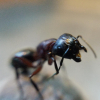Good afternoon fellows it is I Forest with my first colony journal so far (one more on the way later once the queen gets started up). SO to start off this colony is wild caught my grandmother and my stepfather kill any ant they find that is not in my tubes. This is two colonies merged together as Tapinoma can do that apparently. I caught one large colony yesterday August 17th 2019 with about a thousand pieces of brood and over 200 workers but no queens so I went over to my grandmothers house earlier today August 18th 2019 where I have a secret wild Tapinoma colony I keep from her if I need it so I took a tuft of dead grass from under the traffic cone they were under and plopped them in a container to merge them with my others so they would have queens (i captured one I spotter to guarantee I got queens) and i captured 3+ queens in total, about 300+ pieces of brood and about 150 more workers. The colonies are being merged, are showing what I call "merger syndrome" where they fight out of confusion and will eventually get along as they have already stopped fighting at the time of this writing. I have been gradually removing the dead grass while limiting escapees from the formicarium to clean up the setup, the queens have not yet entered the nest as the workers have blocked the entrance to get in with brood(dummies) but the move will be done in the next couple days. expect updates weekly or so or when something happens
No pictures due to a crappy lil flip phone that cannot send pictures here so rip



















